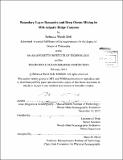| dc.contributor.advisor | Lawrence J. Pratt. | en_US |
| dc.contributor.author | Dell, Rebecca Walsh | en_US |
| dc.contributor.other | Woods Hole Oceanographic Institution. | en_US |
| dc.date.accessioned | 2013-06-17T19:52:54Z | |
| dc.date.available | 2013-06-17T19:52:54Z | |
| dc.date.copyright | 2013 | en_US |
| dc.date.issued | 2013 | en_US |
| dc.identifier.uri | http://hdl.handle.net/1721.1/79282 | |
| dc.description | Thesis (Ph. D.)--Joint Program in Oceanography (Massachusetts Institute of Technology, Dept. of Earth, Atmospheric, and Planetary Sciences; and the Woods Hole Oceanographic Institution), 2013. | en_US |
| dc.description | Cataloged from PDF version of thesis. | en_US |
| dc.description | Includes bibliographical references (p. 160-163). | en_US |
| dc.description.abstract | Physical oceanographers have known for several decades the total amount of abyssal mixing and upwelling required to balance the deep-water formation, but are still working to understand the mechanisms and locations-how and where it happens. From observational studies, we know that areas of rough topography are important and the hundreds of Grand-Canyon sized canyons that line mid-ocean ridges have particularly energetic mixing. To better understand the mechanisms by which rough topography translates into energetic currents and mixing, I studied diffusive boundary layers over varying topography using theoretical approaches and idealized numerical simulations using the ROMS model. In this dissertation, I show a variety of previously unidentified characteristics of diffusive boundary layers that are likely relevant for understanding the circulation of the abyssal ocean. These boundary layers share many important properties with observed flows in abyssal canyons, like increased kinetic energy near topographic sills and strong currents running from the abyssal plains up the slopes of the mid-ocean ridges toward their crests. They also have a previously unknown capacity to accelerate into overflows for a variety of oceanographically relevant shapes and sizes of topography. This acceleration happens without external forcing, meaning such overflows may be ubiquitous in the deep ocean. These boundary layers also can force exchange of large volumes of fluid between the relatively unstratified boundary layer and the stratified far-field fluid, altering the stratification far from the boundary. We see these effects in boundary layers in two- and three-dimensions, with and without rotation. In conclusion, these boundary layer processes, though previously neglected, may be a source of a dynamically important amount of abyssal upwelling, profoundly affecting predictions of the basin-scale circulation. This type of mechanism cannot be captured by the kind of mixing parameterizations used in current global climate models, based on a bottom roughness. Therefore, there is much work still to do to better understand how these boundary layers behave in more realistic contexts and how we might incorporate that understanding into climate models. | en_US |
| dc.description.statementofresponsibility | by Rebecca Walsh Dell. | en_US |
| dc.format.extent | 163 p. | en_US |
| dc.language.iso | eng | en_US |
| dc.publisher | Massachusetts Institute of Technology | en_US |
| dc.rights | M.I.T. theses are protected by
copyright. They may be viewed from this source for any purpose, but
reproduction or distribution in any format is prohibited without written
permission. See provided URL for inquiries about permission. | en_US |
| dc.rights.uri | http://dspace.mit.edu/handle/1721.1/7582 | en_US |
| dc.subject | Joint Program in Oceanography. | en_US |
| dc.subject | Earth, Atmospheric, and Planetary Sciences. | en_US |
| dc.subject | Woods Hole Oceanographic Institution. | en_US |
| dc.subject.lcsh | Abyssal zone Mid-Atlantic Ridge | en_US |
| dc.subject.lcsh | Oceanic mixing | en_US |
| dc.subject.lcsh | Boundary layer | en_US |
| dc.subject.lcsh | Ocean circulation Mid-Atlantic Ridge | en_US |
| dc.title | Boundary layer dynamics and deep ocean mixing in Mid-Atlantic Ridge canyons | en_US |
| dc.type | Thesis | en_US |
| dc.description.degree | Ph.D. | en_US |
| dc.contributor.department | Joint Program in Oceanography | en_US |
| dc.contributor.department | Woods Hole Oceanographic Institution | en_US |
| dc.contributor.department | Massachusetts Institute of Technology. Department of Earth, Atmospheric, and Planetary Sciences | |
| dc.identifier.oclc | 846845713 | en_US |
